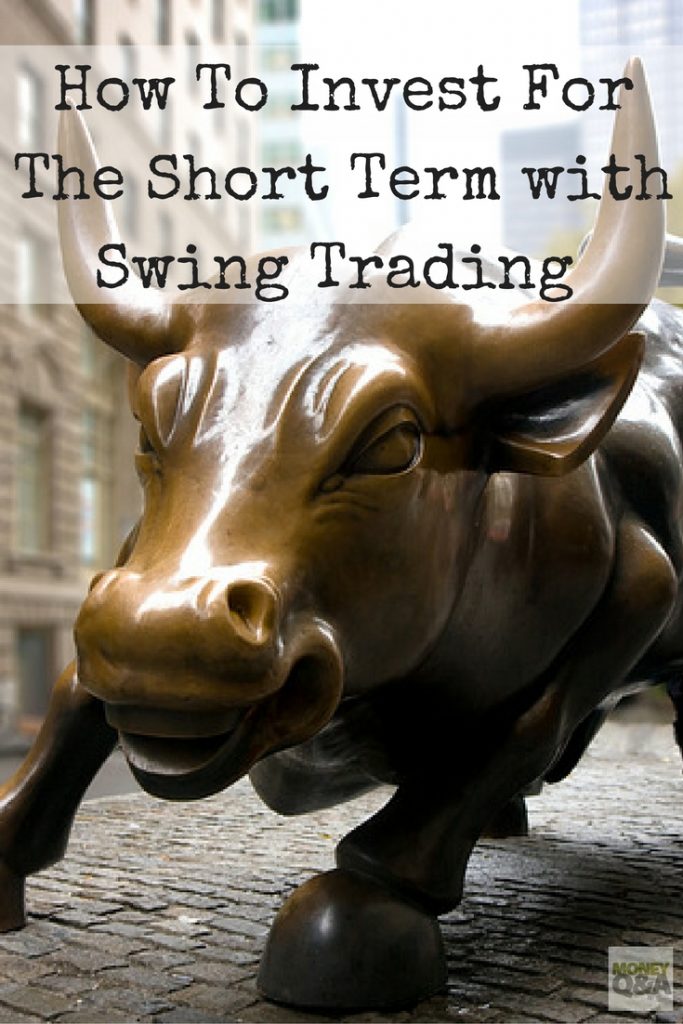
I have a confession to make. For the past six months, I have been buying and selling stocks at a rapid rate lately. It hasn’t been day trading, but I haven’t held a stock for more than a week before selling it. I’ve been swing trading.
I have been swing trading with a small portion of my investment portfolio. I have been buying and selling stock and holding shares for only a few days in the hopes of short term price movements.
And, I am really loving it I have to admit. Like when I started playing fantasy baseball and it renewed my love for the game, short term stock trading has renewed my love for trading.
It’s not for everyone. I will readily admit that. And, I only trade with a very small portion of my total investment portfolio, less than 5%. But, it has been a profitable venture and a lot of fun. I’m up over 20% in the past six months.
What Is Swing Trading?
Swing trading is a speculative investment in individual stocks where the shares are held for only between one to five days. It is very rare that swing traders hold investments for more than a week.
Swing traders look to profit from a stock’s price changes or swings. A swing trading position in a stock or multiple stocks is typically held longer than a day trader would flip stocks but much shorter than your typical buy and hold investor which can hold stocks for months, years, or maybe never sell a share.
Investors who practice swing trading using technical analysis instead of financial analysis to find the potential short term price movements and momentum of stocks they are targeting.
Swing traders are in and out of stocks so rapidly over the course of a few days that they do not typically care about the company’s overall fundamental or intrinsic value of the stock’s shares like a traditional investor who is looking for growth or value stocks to invest in for the long term. Swing traders are looking for share price trends and patterns in the stock charts.
This is rather similar to trading stock CFDs (Contracts for difference) when the trader is also preoccupied mainly with price movements and not the intrinsic value of the underlying asset.
Where To Find Stocks To Trade
For the past six months, I have been using Jason Bond’s Swing Trading service. It is an investment newsletter, and it is the first one that I actually took the plunge and signed up for. I have to admit that I couldn’t be happier.
A friend initially recommended his service, and I decided to give it a try. Now I’m hooked on his newsletter, text alerts, and website for my daily stock trading.
These services are centered around education, teaching new and experienced investors alike how to read technicals and trade stocks based on short term momentum and price movements. Jason is a former teacher with a knack for breaking down concepts and teaching while you follow his stock picking.
While he doesn’t recommend specific stocks per se, he opens up his portfolio to you and alerts clients to trades in real time through his website, emails, chat room, and text message alerts when he is buying and selling a stock.
I was very hesitant at first to sign up for a stock newsletter service on the internet. I had dabbled briefly years ago with Jim Cramer’s Action Alert PLUS. But, I am so glad that signed up for Jason Bond’s Swing Trade service. It has been great.
So far I’ve made over 20% return in six months investing in companies like Zynga, GEVO, GLUU, OCZ, and many other small cap stocks.
Another good swing trading service is K Capital Advisors. Like Jason Bond, K Capital Advisors produce a real-time email newsletter and text service that lets you follow along with their experts as they trade stocks over a short period of time. Become a Successful Swing Trader – K Capital Advisors
If you’re looking for places to keep traditional investment accounts, you might want to check out investing with Betterment, Robinhood, or Stash Invest.
The newest robo-advisor on the market called M1 Finance gives the more established, sophisticated investors great investing options. M1 Finance simplifies the investment process for beginning and experienced investors alike. Unlike other robo-advisors, M1 Finance does not charge a fee, and it gives you the option of taking more control over your investments if you want them (and less if you don’t).
Lessons Learned Swing Trading In Six Months
Like all traders, I have had my ups and downs. I’ve had to hold a few stocks for over a week to earn the rate of return that I was looking for. I have also had to sell a few stocks for a loss.
But, that has been the vast minority of the stocks that I’ve been swing trading these past few months. I would be remiss if I didn’t share with you a few lessons that I have learned along the way of short term swing trading.
Invest Only A Small Portion – Swing trading or any short term trading should only be used with a small portion of your investment nest egg and not with retirement funds. I am only investing in a small 5% portion of my entire portfolio. This will limit the damage if things go completely south.
The vast majority of my investments and retirement funds are in index funds, mutual funds, DRIPs, Roth IRAs, and my company’s 401k retirement plan. Don’t make swing trades with money that you can’t afford to lose.
Have A Goal And An Exit Strategy – As with all investing, you have to have an idea of what you are looking for in the end, and swing trading is no different. Why are you investing? What do you want to earn? 10%? 20%?
You have to know your exit point before you even start to trade. Additionally, to have an exit strategy, you also have to set a stop on how much money you want to lose in any one trade if your shares should take a turn for the worst. Setting a stop to trigger a sell after a 5% or 10% decline can help you limit the amount of money you can lose in a single trade.
Small Investments At A Time – I have finally increased the amount of investment to where I purchase shares in 1,000 share blocks instead of round lots of 100 shares. That’s a little easier when I’m investing in very small cap stocks with share prices of $5 or less and market capitalizations of under $1 billion.
It Takes Patience – Swing trading and short term stock trading takes patience. You have to have a goal or an idea of why you are buying your stocks, and you have to have a goal when you want to sell them. It may take some time, even more than a week, to see if your plan will pan out. You have to have patience with swing trading.
Short term stock trading is not for everyone. And, it is not for your entire portfolio. In fact, I’m still a very firm believer in buy and hold for long term investing goals like retirement, children’s college funds, home mortgage down payments, and the like.
But, short term stock trading with a small portion of your overall investment portfolio can be a fun and very profitable venture to keep you engaged and renew your love for investing. It allows me to put short term cash investments to good use.
Have you dabbled in short term stock trading? Are you a fundamental investor or do you love technical analysis? I’d love to hear your thought in the comment section below.
Note: Some of the links listed above contain affiliate links where I’ll receive compensation if you choose to use any of these services. I’ve personally used all of the services listed on this page and can attest to their performance. I definitely recommend them all.




I used to do a lot of short term trading with ProShares Index ETFs. I wouldn’t make moves every week, but a few years ago when 1% daily moves were frequent there was a lot of short term money that could be made.
I’ve been investing in high beta small cap stocks that tend to move a lot one way or another. While they are definitely volatile, it helps move the share prices in the short-term.
A lot of people I know recently started swing trading. Well recently as in the last 6-12 months. I am not comfortable with it yet so I have yet to take the plunge. Seems like a lot more work then I have time for to be honest with keeping up with the blog, and other things. Do you set limit orders or is this something you really need to be watching?
I always set limit orders. While it can take a little bit of work, I really enjoy it. But, you’re right limit orders are the way to go for sure so I don’t have to watch my positions all the time.
Nice blog!!! I have heard of swing trading and never ventured into it as I didn’t know the details about it. But definitely would like to give it a try. And would like to reserve just a small portion of my investment on it. I am convinced about having to set a stop on how much money you want to lose in any one trade if your shares should take a turn for the worst. Setting a stop to trigger a sell after a 5% or 10% decline can help you limit the amount of money you can lose in a single trade. Will surely go with this. Thank you for this information.
Victor,
You are absolutely right. You have to know how much you want to not only gain but are willing to lose on a bad trade right from the beginning and stick to it. That’s the hard part…sticking to the plan when prices move quickly one way or another. Setting your stops and limit orders is definitely the way to go.
Interesting! But I wonder what are the other risks in swing trading? Would you recommend it to anyone who would want to get into any kind of trading?
Swing trading may be lots of fun now, while the market is going up. Heck, it’ll even be fun when the market is sideways. But you can get burned badly when the market starts going downhill!
Hank, what trading service do you recommend to execute swing trading? Can you talk more on Limit orders, as mentioned above is the comments.
Great questions, Robert. I typically use a discount brokerage service like Scottrade, which has now be bought out by TD Ameritrade. I’ve also been dabbling in using the app Robinhood, which offers free trades with no commissions which is pretty cool. http://share.robinhood.com/hughc4 (affiliate link). It’s definitely worth trying out.
Great question on Limit Orders. I definitely need to write something about them soon here on Money Q&A. I ALWAYS use a limit orders! Everyone should. You should almost never place a market order. The price of a market order may move on you faster than a trade is executed making you buy or sell stocks a price you didn’t want. If you’re trading in and out fairly fast like swing trading or day trading low priced stocks, a few pennies could hurt your profits. A limit order will only buy a the price you set or lower. You may miss a fast moving stock whose price is fluctuating though. You’ll have to stay on top of it and maybe adjust your bid price in that case. I also often put in a stop loss limit order, which triggers a sell when the shares hit a particular price in an effort to limit my losses.